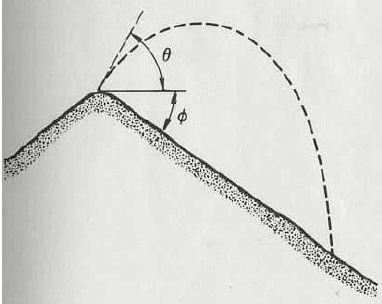What is the horizontal range of the stone when the stone strikes the ground?
A person is standing on top of a hill that slopes downwards uniformly at an angle ! with respect to the horizontal. The person throws a stone at an initial angle !0 from the horizontal with an initial speed of v0 . You may neglect air resistance. What is the horizontal range of the stone when the stone strikes the ground?

Can I set the coordinate system as follows: Choose the origin to be at the tip of the inclined plane, the x-axis along the inclined plane and the y-axis perpendicular to the inclined plane.
With this coordinate system, the angle the initial speed makes with the x-axis is θ+Φ. We resolve the acceleration due to gravity and initial velocity vector into their 2 components
ax+ay=(gsinΦ)i-(gcosΦ)j
v0=vxi+Vyj=v0cos(θ+Φ)i+v0sin(θ+Φ)j
Then write down the complete set of kinematics for each independent direction x and y describing the position and velocity at instant, t.
Why is my approach to solving the problem incorrect?
A person is standing on top of a hill that slopes downwards uniformly at an angle ! with respect to the horizontal. The person throws a stone at an initial angle !0 from the horizontal with an initial speed of v0 . You may neglect air resistance. What is the horizontal range of the stone when the stone strikes the ground?

Can I set the coordinate system as follows: Choose the origin to be at the tip of the inclined plane, the x-axis along the inclined plane and the y-axis perpendicular to the inclined plane.
With this coordinate system, the angle the initial speed makes with the x-axis is θ+Φ. We resolve the acceleration due to gravity and initial velocity vector into their 2 components
ax+ay=(gsinΦ)i-(gcosΦ)j
v0=vxi+Vyj=v0cos(θ+Φ)i+v0sin(θ+Φ)j
Then write down the complete set of kinematics for each independent direction x and y describing the position and velocity at instant, t.
Why is my approach to solving the problem incorrect?
3 Answers
I can answer in principle, but not give a specific answer as the data hasn't appeared in the question.
Explanation:
Firstly, make sure you analyse vertical and horizontal motion separately - they are completely independent.
You need to find the time of flight (suggest
Yes, you could set the coordinate system as you suggest; and then convert from down the slope distance to horizontal distance for the final answer.
Explanation:
If you did what you suggested, and it was marked incorrect, I suspect you did not then convert down the slope distance to horizontal distance. If the distance down the slope you calculated was x, then the horizontal range,
I hope this helps,
Steve
See below.
Explanation:
Assuming the origin of coordinates at the very top, the kinematic movement equations are
The inclined plane is described by
so the intersection is given at
now solving for



